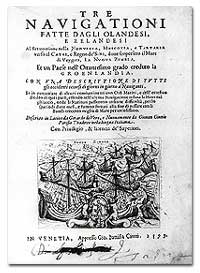

International interest
A multitude of editions and translations of De Veer's account appeared around 1600. Various publishers used Claesz's material for their own commercial prosperity:
1598: 1st German edition, published by Levinus Hulsius. [illustration 12] Illustration 12. Title-page to the first German edition of the Dutch voyages to the North, Warhafftige Relation der dreyen newen unerhörten seltzamen Schiffart... (Levinus Hulsius, Nuremburg 1598). |
 |
 |
1599: 1st Italian edition, published by Giov. Batt. Ciotti. [illustration 13] Illustration 13. Title-page to the first Italian edition of the Dutch voyages to the North, Tre navigationi fatte dagli Olandesi... (Giovanni Battista Ciotti, Venice 1599). De Veer's account received most of the attention.
2nd French edition, published by Guillaume Chaudière. 2nd German edition, published by the De Bry brothers. |
1601: 1st Latin edition, published by the De Bry brothers.
1602: 2nd edition of Hulsius's German version.
1606: 2nd Italian edition, published in the collection of Giov. Batt. Ramusio.
The collection of voyages produced in Frankfurt by the De Bry family is a case in point. The De Brys, copper-engravers as well as shrewd publishers with a keen eye for commercial opportunities, assembled travel accounts from various authors, and had them translated into German and Latin. They made the narratives available for a learned and affluent readership in exclusive folio-volumes. De Veer's account was included in this monumental series within two years of its initial appearance in Amsterdam. Since the De Bry series was bought and read throughout early modern Europe, De Veer's report of Novaya Zemlya attracted broad attention.
Intriguingly, the De Brys and their German fellow-publisher Levinus Hulsius added one important engraving to their translations of De Veer's report which had not been included in the original Dutch edition:

Remarkably, the illustration corresponds in detail to the lay-out of the Behouden Huys, which was recovered by archaeologists in the 19th and 20th centuries, fuelling speculation that the Frankfurt publishers enjoyed a very close relationship with Cornelis Claesz. Unless De Veer or one of the crew members had established close connections with the De Brys, which is unlikely, Claesz must have provided the illustration to his German colleagues.
>More information on the archaeological finds of Novaya Zemlya can be found here.
